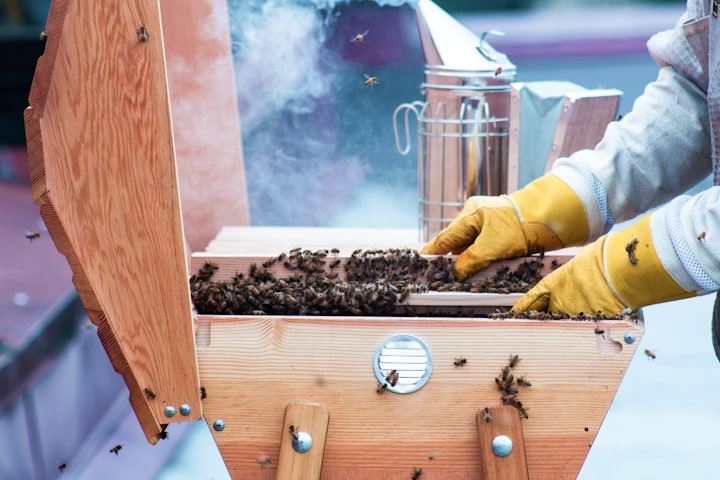Be(e)ing mindful
How the art of keeping bees makes life sweeter

The keeper of honeybees (Apis mellifera) is one who practices age-old and dynamic forms of art, poetry, and science. To the uninitiated, beekeeping may appear to involve precise method and skill, much as one would learn how to measure or mix a reagent. But a new beek (informal slang used to mean either “beekeeper” or “bee geek,” depending on who you ask) – even one who has just barely scratched the surface of beekeeping as a hobby – will realize that beekeeping is actually a very complicated dance, one that requires mindfulness and all available senses, between the keeper and a super organism of wild animals.
Nearly from the very beginning of my journey as an aspiring apiarist, starting with the decision of what hive set-up to use, the fact that beekeeping was a creative art became apparent. I’m someone who forever searches for the “best” answer or the “right” answer, so this was incredibly frustrating to me at first. But, as the droll saying goes, “Ask ten beekeepers a question and get a dozen answers.” Sure, you may have some practical reasons for preferring one set-up over another, such as a bad back that may keep you from lifting heavy boxes full of brood and honey, but realistically speaking it comes down to your creativity and artistic choice. The same is true for every decision that an apiculturist needs to make: from mite treatment (or not) to harvesting honey or how to requeen a hive. Making decisions this way – when there is no “right” answer – requires grounding and self-reflection. It asks me, as a beekeeper, to decide: How do I wish to ultimately practice this art? What kind of keeper do I want to be?
Applying this art of mindfulness, grounding, and self-reflection is also important when working directly with the bees. Honeybees are fascinating creatures for so many reasons, one of which is that they can respond to the moods of humans. They do this through their sense of smell and by deciphering the pheromones that we release based on our emotional states. Honeybees are able to sense smell through receptors on their mouth parts, antennae, and on their feet. Their sense of smell is 100x that of humans, 50x that of dogs, and they can detect scent molecules in the range of parts per trillion. If you work a hive from a place of anger, your bees will read the pheromones and chemosignals you release as a threat. Additionally, honeybees are stimulated to attack by vibrations (think quick or jerky movements) and increased carbon dioxide, both signs of anger or agitation. They react accordingly to these signals, which means that both you and your bees will have an unpleasant time. Bees sting when threatened only as a last resort to protect themselves or their hive, but since honeybee stingers are barbed, they cannot withdraw them from their target and die soon after. Being present and grounded in the moment is crucial for working with bees. Beekeeping forces me to be mindful, intentional, breathe deeply, stay calm, and to move without haste both to reduce my chances of getting stung but also to save the lives of the bees themselves.
Helpful in this endeavor is the fact that most if not all, beehives are outside - my top bar hives are at the back of my garden area. This is useful because spending time out of doors is known to lower cortisol levels. Our bodies release cortisol when we’re stressed, and increased levels contribute to depression, anxiety, and other mental health issues. Not only that, but being outside helps relieve Computer Vision Syndrome, and is linked to higher levels of creativity, concentration, and mental clarity. Harvard Medical School researchers have noted that just watching nature can have brain benefits. Those who spend time in nature show less activity in their prefrontal cortex, an area of the brain active during repetitive thoughts that can also lead to bad feelings. Being outside with my bees has been an invaluable tool to me as someone who is neurodivergent, works a desk job staring at a computer all week, and is arguably as useful as my medications in managing my type-II bipolar disorder.
I’m not the only one who has made these connections. Though little hard data exists so far to correlate beekeeping with improved diagnoses, there are multiple instances of beekeeping being used around the world as intervention or as informal therapy for veterans, refugees, and inmates. Shari LaGrange-Aulich, a clinical psychologist specializing in post-traumatic stress, suicide, and brain injuries co-created the SAVE Farm in Kansas, a training farm for veterans and transitioning service members. She has noted a number of positive psychosocial and behavioral outcomes for participants as a result of the SAVE Farm’s beekeeping program, including behavioral activation, a sense of purpose, increased stress tolerance, social cooperation, emotional regulation, and mindfulness.

I absolutely agree with LaGrange-Aulich’s initial observations. Part of the way that beekeeping helps me stay mindful and leads to these positive correlations is that it requires all of my senses. The bees may be able to smell what’s going on with me, but I can hear, see, feel, taste, and smell what’s going on with them as well. Before I even open the hive, the first thing I’ll notice is their sound. Does their humming sound frenetic and upset, or is it the lazy, content humming of business as usual? I also look at the entrance to the hive and the landing board, the bee equivalent of a foyer, to see what their activity looks like. Ordinary activity consists of bees going in and out, guard bees at the door checking everyone’s credentials, and sometimes communicative dancing by a bee or two to inform the others of where the best pollen is or the closest watering hole. If their behavior differs from any of that, it may signify a problem that needs addressing such as pesticide exposure or a queenless hive.
Once I remove the roof and start looking at the bars of comb, the rest of my senses engage. I can see what the comb looks like, if it’s full of honey or larva or both, and I can see the bees themselves and their activity more clearly. I can still hear what’s going on with them, of course, but at this point I am also able to smell, feel, and even taste if I want to. Bees smell like a combination of a fresh wild breeze, delicious flowers, old wood, and sunshine. They also excrete pheromones that can help me gauge their mood. For instance, their alarm pheromone smells like bananas, and if I start smelling it I know that it’s time to close up the hive and come back another day. Physically, their bars of comb may feel heavy or light, depending on the season and their contents, all of which gives me, the beekeeper, good information. Energetically speaking, the honeybees themselves may feel agitated or calm, morose or contented. I may also have bees dive-bombing my veil, looking to score an entrance to sting, which tells me that they feel threatened or are otherwise upset by something. And the taste of honey or comb may give me an indication of what kind of nectar and pollen they’ve been foraging.
All of that is to say that beekeeping requires mindfulness, grounding myself in my own body, staying present, and being attuned to all of my senses. Honeybees are excellent communicators, if I slow down and take the time to understand them.

Like all other kinds of mindful making endeavors, beekeeping is an art that takes time, persistence, and practice. Just as if I were to learn how to sing, cross-stitch, or do yoga, it’s not something that I know how to do or will be good at automatically. I have a paralyzing fear of failure, and the learning curve to become a beekeeper is steep and full of pitfalls. But, while this is certainly frustrating and sometimes disheartening, it is also a matter of hard-won personal growth, and makes accomplishments more rewarding for me as I master each new skill, perform new tasks, and achieve new milestones. This is also noted by the Oregon based non-profit Cascade Girl, who remark that becoming a beekeeper may result in increased confidence and a positive change in self-concept.
In addition, despite the fact that beekeeping spans millennia, there is still a lot of room and space for creativity. Beekeeping is an accessible practice for many in that it is not “owned” by anyone or anything, and the materials for it are relatively commonplace, so, even hobbyist and backyard apiarists are constantly coming up with new and improved hive designs and ways to manage bees. Not only that, but many beekeepers artistically paint, decorate, carve, or otherwise adorn their hives. Relatedly, beekeeping has been somewhat of a “gateway practice” for me creatively. It’s not just sinking into the zen of managing my hive, but it has also led me to photography of the bees and the hive components, gardening as I work to plant and maintain vegetation that is beneficial to pollinators, and reading and writing (both fiction and non) about bees and beekeeping. In the future I, too, may choose to whimsically paint my hives or take up woodworking to be better able to design and repair my own materials. The possibilities and potential for creative immersion are endless and only really limited by my own desires.
Beekeeping is a multifaceted and deeply engaging practice that not only has space for creativity and art but is also “mindful making” and offers us inner peace, grounds us, and helps us escape the stressful day-to-day grind. It has been informally shown to improve mental and emotional health for those who practice it. In addition, not only is it good for us on an individual level, but since honeybees help pollinate 80% of the world’s plants – including 1 out of every 3-4 bites of food we eat – beekeeping is also good for the world on a macro level. One may even say that we don’t keep bees, the bees keep us.
About the Creator
Max Gibbs-Ruby (he/him or they/them)
Max is passionate about social justice and political activism, living his life "out loud," and just generally making the world a better place. He lives on a small homestead in western Washington (U.S.).






Comments
There are no comments for this story
Be the first to respond and start the conversation.